Hand grenades are small bombs, containing explosives or
chemicals, that can be thrown or rigged as booby traps.
They are used at short range and the effective casualty
radius is relatively small. The built-in, delayed fuse delay allows you to
safely throw it and seek cover before it explodes.
There are four basic types of hand grenades,
Fragmentation, Illumination, Chemical, and Incendiary. |

|
The "Safety Pin" holds the "Safety Lever" in place.
Unless you hold the "Safety Lever" down with your hand, removal of the
"Safety Pin" allows the "Safety Lever" to spring away from
body of the grenade. This action starts the fuse (varying from a few seconds to
no seconds) which then sets off the grenade.
To Throw a Grenade:
-
Hold the grenade in your throwing arm, making sure the "Safety
Lever" is held securely to the side of the grenade.
-
Using the "Pull Ring," remove the safety pin.
-
Keeping your eyes on the target, throw the grenade, using an
overhand throw. As soon as the grenade is released, the "Safety
Lever" will fly off, igniting the fuse.
-
Duck down behind cover and await detonation. If there is no cover,
fall to the ground with your helmet toward the grenade.
To Secure a Grenade:
-
Be very careful in removing grenades from clothing, pouches, or web
gear. "Safety Pins" are relatively firmly attached to the
grenade at the factory, but may have been tampered with. If the
"Pull Ring" gets snagged on clothing as you remove the
grenade, and if you don't hold onto the "Safety Lever," the
fuse will be ignited and within a few seconds, the grenade will
explode.
-
Grasp the grenade, making sure to hold down the "Safety
Lever."
-
Watching the "Pull Ring," ease the grenade out of
patient's pocket, or web gear.
-
Wrap a strip of adhesive tape completely around the grenade, so that
the "Pull Ring" and "Safety Lever" are firmly
bound to the body of the grenade.
-
Set the grenade down in a safe place.
To Avoid Injury from a Grenade that Lands Near You:
-
Yell out very loudly: "GRENADE!" This will
help prevent injury to your friends.
-
Duck down beneath any kind of cover that makes sense. Ducking behind
a tent flap won't help. Ducking behind a packing crate, desk, rock or
any other substantial structure will help a lot.
-
If there is no cover, drop to the ground, remaining as flat as
possible and giving the grenade as small a target as possible.
-
If you are in a slit trench or fortified bunker, you may find that
there is "grenade sump" located at the bottom of the trench.
The idea here is that when a grenade comes in, you can quickly kick
the grenade into the sump. When it explodes, the force of the
explosion will be directed straight up, sparing the occupants of the
trench any injury. You may as well try it, as you have little to lose.
-
Whatever you decide to do, do it quickly as you only have 0-3
seconds before the grenade will detonate.
-
If you are in the middle of a fight and you are wounded by a
grenade, keep fighting, as that gives you and your friends the
best chance of survival.
|
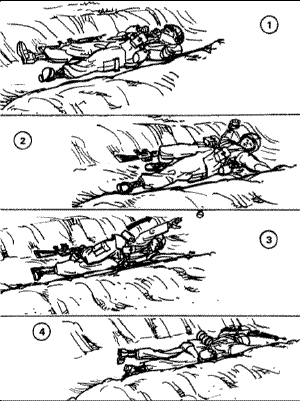
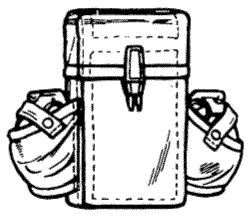
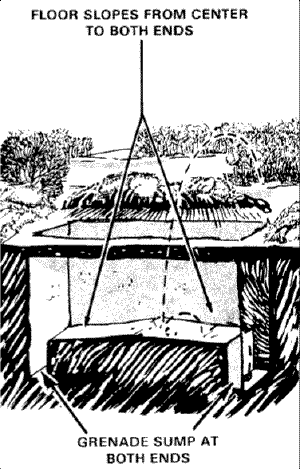 |
Things to Know about Specific Grenades:
M67 Fragmentation Grenade:
-
Body is a steel sphere.
-
Olive drab color with a single yellow band at the top.
-
Fragments are from a serrated wire coil inside the grenade body.
-
Weight is 14 ounces
-
Fuse Delay: 4-5 seconds
-
Average soldier can throw it about 40 meters...shorter distances
more accurately.
-
Killing radius: 5 meters
-
Wounding radius: 15 meters
-
Danger from stray fragments: 230 meters
|
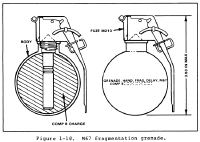 |
M61 Fragmentation Grenade
-
Body is thin sheet metal.
-
Olive drab color with a single yellow band at the top.
-
Fragments are from a serrated wire coil inside the grenade body.
-
Weight is 16 ounces
-
Fuse Delay: 4-5 seconds
-
Average soldier can throw it about 40 meters...shorter distances
more accurately.
-
Killing radius: 5 meters
-
Wounding radius: 15 meters
-
Danger from stray fragments: 230 meters
|
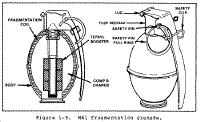 |
M15 White Phosphorous Grenade
-
Used for signaling, screening, and incendiary purposes.
-
Body is sheet metal, contains 15 ounces of white phosphorous.
-
Grey in color with a single yellow band.
-
Total weight: 31 ounces.
-
Fuse Delay: 4-5 seconds
-
Average soldier can throw the grenade 30 meters.
-
Bursting radius: 17 meters. All friendly personnel within this
17-meter area should be in a covered position to avoid being struck by
burning particles.
-
WP filler burns for about 60 seconds at a temperature of 5,000
degrees,.
-
Burns from the WP are treated in the usual way unless particles of
WP are embedded in the skin. In that case, immerse the wound in water
or pack with wet cloths to halt combustion. Then pick out or squeeze
out the WP. The particles will reignite spontaneously if allowed to
dry. Apply copper sulphate
solution to halt combustion of the WP particles. This permits them to
be removed without igniting.
|
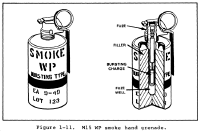 |
AN-M8 HC Smoke Grenade
-
Used to produce dense clouds of white smoke for signaling and
screening.
-
Body is a sheet steel cylinder, filled with HC smoke mixture.
-
Light green body with white top.
-
Weight: 24 ounces
-
Fuze Delay: 1.2 to 2 seconds
-
Average soldier can throw it 30 meters.
-
Emits a dense cloud of white smoke for 105 to 150 seconds.
-
If damaged with exposure of the filler material, spontaneous
ignition can occur, particularly in the present of moisture and air.
-
Produces some hydrochloric acid fumes that can irritate the eyes,
throat and lungs. For that reason, if used in a closed space,
protective masks should be employed by friendly forces.
-
Treatment of symptoms involves immediate removal from the exposure,
observation for delayed effects, and treatment of bronchospasm with
vasodilators, steroids, and antibiotics (long-term) as
indicated.
|
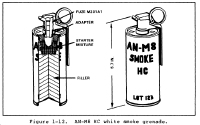 |
M18 Colored Smoke Grenade
-
Used as a ground-to-ground or ground-to-air signaling device, a
target or landing zone marking device, or a screening device for unit
movements.
-
Body is a sheet metal cylinder with four emission holes at the top
and one at the bottom to allow smoke release when ignited.
-
Olive drab body with top color-coded to indicate the color of smoke.
-
Smoke may be red, green, yellow or violet.
-
Weight: 19 ounces.
-
Fuze Delay: 1.2 to 2 seconds.
-
Average soldier can throw it 35 meters.
-
Produces a cloud of colored smoke for 50 to 90 seconds.
-
Cannister becomes very hot when ignite and may set dry grass or
brush on fire.
|
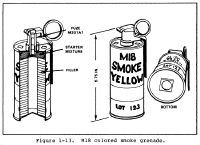 |
ABC-M7A2 and the ABC-M7A3 Riot Control Hand
Grenades
-
Used to dispense CS gas for riot control.
-
Body is sheet metal with four emission holes on the top and one on
the bottom.
-
Grey in color with a single red band.
-
Weight: 15.5 ounces.
-
Fuze Delay: 1.2 to 2 seconds
-
Average soldier can throw it 40 meters.
-
Releases a cloud of CS gas (Tear gas) for 15 to 35 seconds.
-
Produces burning sensation in the eyes, with tearing and
photophobia. Respiratory symptoms include burning, pain and a
sensation of suffocation. Skin symptoms may include a burning
sensation, particularly in moist areas.
-
Most casualties require no medical care and the symptoms resolve
spontaneously in 30-60 minutes.
-
First Aid:
-
Move the victim into fresh air, facing them into the wind.
-
Change clothing
-
If symptoms persist, rinse eyes and mouth with water, use soap
and water on the skin.
-
Reassure the victim
-
In the event of massive exposure, the skin may blister (treat it
like a burn) and the lungs may be damaged (requiring intensive
care, such as ventilatory support, steroids, and antibiotics).
For further information on the medical treatment of these injuries,
read:
|
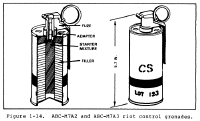 |
ABC-M25A2 Riot Control Hand Grenade
-
A bursting munition with an integral fuze, used to dispense riot
control agents.
-
Body: Compressed fiber or plastic.
-
Gray body with red band.
-
Filler agent varies.
-
Weight: 8 ounces
-
Fuze Delay: 1.4 to 3 seconds
-
Average soldier can throw it 50 meters
-
Radius of burst (visible cloud agent) is about 5 meters, but grenade
fragments may project as far as 25 meters.
|
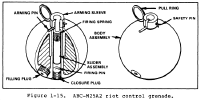 |
AN-M14 TH3 Incendiary Hand Grenade
-
Used to destroy equipment, including vehicles, weapons systems,
shelters, or munitions. The grenade may also be used to start fires in
areas containing flammable materials.
-
Uses TH3 a form of thermite, which burns at very hot temperatures
for 40 seconds, burning through 1/2 inch of steel plate and fuzing
metalic parts.
-
It produces its' own oxygen, so it can burn under water.
-
Body: sheet metal.
-
Gray with a single purple band. Some may be found light-red in color
with black markings.
-
Weight: 32 ounces
-
Fuze Delay: 1.2 to 2 seconds
-
Avoid looking directly at the grenade when it is burning as the
intense light may damage the retina.
|
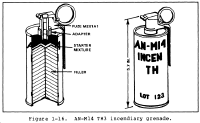 |
MK3A2 Offensive Hand Grenade (Concussion
Grenade)
-
Used to produce casualties during close combat while minimizing
danger to friendly personnel. The grenade is also used for concussion
effects in enclosed areas, for blasting, or for demolition tasks. The
shock waves (overpressure) produced by this grenade when used in
enclosed areas are greater than those produced by the fragmentation
grenade. It is, therefore, very effective against enemy soldiers
located in bunkers, buildings, and fortified areas.
-
Body: fiber, black in color with yellow markings.
-
Weight 15.6 ounces
-
Fuze Delay: 4-5 seconds
-
Average soldier can throw it 40 meters.
-
In open areas, effective casualty radius is 2 meters. In closed
areas, the radius may be larger, due to overpressure effects.
-
Secondary missiles and fuze pieces may be projected as far as 200
meters from the point of detonation.
|
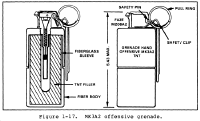 |
M69 Practice Hand Grenade
-
Used to simulate the M67-series of fragmentation hand grenades for
training purposes.
-
Body: Steel, colored light blue with white markings
-
Weight: 14 ounces
-
Fuze Delay: 4-5 seconds
-
On detonation, emits a small puff of white smoke and makes a loud
popping sound.
-
Fuze fragments may exit the hole in the base of the grenade, causing
injury.
|
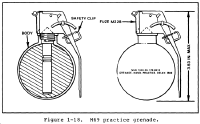 |
Home
· Military Medicine
· Sick Call · Basic Exams
· Medical Procedures
· Lab and X-ray · The Pharmacy
· The Library · Equipment
· Patient Transport · Medical Force
Protection · Operational Safety · Operational
Settings · Special
Operations · Humanitarian
Missions · Instructions/Orders · Other Agencies · Video Gallery
· Forms · Web Links · Acknowledgements
· Help · Feedback
Approved for public release;
Distribution is unlimited.
Bureau of Medicine and Surgery
Department of the Navy
2300 E Street NW
Washington, D.C
20372-5300 |
Operational Medicine
Health Care in Military Settings
CAPT Michael John Hughey, MC, USNR
NAVMED P-5139
January 1, 2001 |
United States Special Operations
Command
7701 Tampa Point Blvd.
MacDill AFB, Florida
33621-5323 |
*This web version is provided by The Brookside Associates, LLC. It contains
original contents from the official US Navy NAVMED P-5139, but has been
reformatted for web access and includes advertising and links that were not
present in the original version. The medical information presented was reviewed and felt to be accurate in 2001. Medical knowledge and practice methods may have changed since that time. Some links may no longer be active. This web version has not been approved by the
Department of the Navy or the Department of Defense. The presence of any
advertising on these pages does not constitute an endorsement of that product or
service by either the US Department of Defense or the Brookside Associates. The
Brookside Associates is a private organization, not affiliated with the United
States Department of Defense.
© 2015, Brookside Associates, LLC. All rights reserved
Other Brookside Products

|